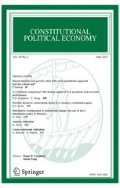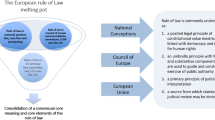Abstract
The migration out of Europe and the establishment of North American colonies presents us with a great puzzle: why did the colonists establish democratic forms of governance? Considering that early democratic colonies appeared even before philosophical works such as those of Locke and Montesquieu were written, it is difficult to make the case that ideology was the driving factor. We show that the calculus of consent model proposed by Buchanan and Tullock (The calculus of consent, Liberty Fund, Indianapolis, 1962) offers a simple but subtle solution this puzzle. Because migrants formed much more homogeneous communities, and because, thanks to the large geographical expanse, the inter-jurisdictional externalities were small, the efficient level of consensus within each colony was much greater than in Europe, and the scope of efficient centralized decision-making was much smaller. Hence, a structure of decentralized democratic communities emerged as the efficient outcome.




Similar content being viewed by others
Notes
Mathematically, this means that \(\delta D\) and \(\delta E\) are inexact differentials, i.e. they (as well as their integrals) are path dependent. They depend not just on the sheer number of people (or jurisdictions), but also on which people (jurisdictions) specifically are added (or subtracted). For example, adding a small group of people that is culturally very different from the existing population, would increase the decision-making costs much more than adding a small group of the same size but of culturally similar people.
We can also think of this through the lens of knowledge rather than incentives (Page 2007). The external cost of a collective decision is due to taking a mistaken decision. This is made less likely if more points of view are included, hence avoiding groupthink. But if the population is relatively homogeneous, more people are needed for securing a diversity of viewpoints. If the population is relatively heterogeneous, even a small (random) sampling will lead to a diverse set of perspectives.
References
Acemoglu, D., Johnson, S., & Robinson, J. A. (2001). The colonial origins of comparative development: An empirical investigation. The American Economic Review, 91(5), 1369–1401.
Acemoglu, D., & Robinson, J. A. (2012). Why nations fail: The origins of power, prosperity, and poverty. New York: Crown Publishing.
Aligica, P. D., & Tarko, V. (2014). Capitalist alternatives: Models, taxonomies, scenarios. London and New York: Routledge.
Appleby, J. (1976). Liberalism and the American revolution. The New England Quarterly, 49(1), 3–26.
Appleby, J. (1978). The social origins of American revolutionary ideology. Journal of American History, 64(4), 935–958.
Appleby, J. (1984). Capitalism and a new social order: The republican vision of the 1790s. New York: New York University Press.
Archer, R. (1990). New England mosaic: A demographic analysis for the seventeenth century. The William and Mary Quarterly, 47(4), 477–502.
Arrow, K. J. (1951). Social choice and individual values. New Haven: Yale University Press.
Bailyn, B. (1967). The ideological origins of the American Revolution. Cambridge, MA: Harvard University Press.
Bailyn, B. (1986). Voyagers to the west. New York: Random House.
Beito, D. (1992). From mutual aid to the welfare state: Fraternal societies and social services. Cambridge: University of North Carolina Press.
Black, D. (1958). The theory of committees and elections. Cambridge: Cambridge University Press.
Brascoupé, S., & Etmanskie, J. (2006). Iroquois. In J. Birx (Ed.), Encyclopedia of anthropology. Thousand Oaks, CA: Sage Publications.
Buchanan, J. M. 1968 [1999]. The demand and supply of public goods. Indianapolis, IN: Liberty Fund.
Buchanan, J. M. (1987). Justification of the compound republic: The calculus in retrospect. Cato Journal, 7, 305–312.
Buchanan, J. M., & Tullock, G. 1962 [1999]. The calculus of consent. Indianapolis, IN: Liberty Fund.
Congleton, R. (2011). Perfecting parliament: Constitutional reform, liberalism, and the rise of western democracy. New York: Cambridge University Press.
de Figueiredo, R. J. P., Jr, Rakove J., & Weingast, B. R. (2006). Rationality, inaccurate mental models, and self-confirming equilibrium: A new understanding of the American Revolution. Journal of Theoretical Politics, 18(4), 384–415.
Denzau, A. T., & North, D. C. (1994). Shared mental models: Ideologies and institutions. Kyklos, 47(1), 3–31.
Diamond, S. (1967). Values as an obstacle to economic growth: The American colonies. Journal of Economic History, 27(4), 561–575.
Downs, A. (1957). An economic theory of democracy. New York: Harper & Brothers.
Ekelund, R. B., & Tollison, R. D. (1981). Mercantilism as a rent-seeking society: Economic regulation in historical perspective. College Station, TX: Texas A&M University Press.
Fenton, W. N. (1998). The great law and the longhouse: A political history of the Iroquois Confederacy. Norman: University of Oklahoma Press.
Fischer, D. H. (1989). Albion’s seed: Four British folkways in America. New York: Oxford University Press.
Fogel, R. W., & Engerman, S. L. (1974). Time on the cross: The economics of American Negro slavery. Boston, MA: Little, Brown and Company.
Gilardi, F. (2004). Institutional change in regulatory policies: Regulation through independent agencies and the three new institutionalisms. In J. Jordana & D. Levi-Faur (Eds.), The politics of regulation: Institutions and regulatory reforms for the age of governance (pp. 67–89). Cheltenham: Edward Elgar.
Hirshleifer, J. (2001). The dark side of the force: Economic foundations of conflict theory. Cambridge: Cambridge University Press.
Innes, S. (1995). Creating the commonwealth: The economic culture of Puritan New England. New York: W. W. Norton & Company.
Kossinets, G., & Watts, D. J. (2009). Origins of homophily in an evolving social network. American Journal of Sociology, 115(2), 405–450.
Leeson, P. T. (2006). Cooperation and conflict. American Journal of Economics and Sociology, 65(4), 891–907.
Leeson, P. T. (2014). Anarchy unbound: Why self-governance works better than you think. Cambridge, New York: Cambridge University Press.
Lemke, J. S. (2016). Interjurisdictional competition and the Married Women’s Property Acts. Public Choice, 166(3–4), 291–313.
McCloskey, D. (2006). The bourgeois virtues: Ethics for an age of commerce. Chicago: University of Chicago Press.
McCloskey, D. (2010). Bourgeois dignity: Why economics can’t explain the modern world. Chicago: University of Chicago Press.
Meinig, D. W. (1986). The shaping of America: Atlantic America, 1492–1800. New Haven: Yale University Press.
North, D. (1990). Institutions, institutional change and economic performance. New York: Cambridge University Press.
Nye, J. V. C. (1997). Thinking about the state: Property rights, trade, and changing contractual arrangements in a world with coercion. In J. N. Drobak & J. V. C. Nye (Eds.), Frontiers of the new institutional economics. London: Academic Press.
Nye, J. V. C. (2007). War, wine, and taxes: The political economy of Anglo-French trade, 1698–1900. New Jersey: Princeton University Press.
Olson, M. (1965). Logic of collective action: Public goods and the theory of groups. Cambridge: Harvard University Press.
Olson, M. (1993). Dictatorship, democracy, and development. American Political Science Review, 87(3), 567–576.
Ostrom, V. (1987). The political theory of a compound republic: Designing the American experiment. Third, Revised edition. Lanham, MD: Lexington Books.
Ostrom, E., & Ostrom, V. (2004). The quest for meaning in public choice. American Journal of Economics and Sociology, 63(1), 105–147.
Page, S. E. (2007). The difference: How the power of diversity creates better groups, firms, schools, and societies. Princeton: Princeton University Press.
Reichel, P. L. (1992). The misplaced emphasis on urbanization in police development. Policing and Society: An International Journal, 3(1), 1–12.
Richter, D. K., & Merrell, J. H. (Eds.). (2003). Beyond the covenant chain: the Iroquois and their neighbors in Indian North America, 1600–1800. University Park, PA: Pennsylvania State University Press.
Riker, W. H. (1962). The theory of political coalitions. New Haven: Yale University Press.
Stigler, G. J. (1992). Law or economics? Journal of Law and Economics, 35(2), 455–468.
Tarko, V. (2015). The role of ideas in political economy. The Review of Austrian Economics, 28(1), 17–39.
Taylor, A. (2001). American colonies. New York: Penguin Books.
Tullock, G. (1980a). Efficient rent seeking. In Buchanan, Tollison & Tullock (1980: pp. 97–112).
Tullock, G. (1980b). Rent-seeking as a negative-sum game. In Buchanan, Tollison & Tullock (1980: pp. 16–36).
Tullock, G. (1989). Rents, ignorance, and ideology. In The economics of special privilege and rent seeking. Studies in public choice (pp. 11–27). Dordrecht: Springer.
Tullock, G. (1991). Rent seeking. In J. Eatwell, M. Milgate, & P. Newman (Eds.), The new Palgrave: The world of economics. New York: W.W. Norton.
Wagner, R. E. (1988). The calculus of consent: A Wicksellian retrospective. Public Choice, 56(2), 153–166.
Wood, G. S. (1993). The radicalism of the American Revolution. New York: Vintage Books.
Acknowledgements
We thank Peter Boettke, Geoffrey Hodgson, Peter Leeson, Georg Vanberg, Richard Wagner and two anonymous reviewers for their comments on earlier versions of this paper. We also gratefully acknowledge the financial supportfrom the Mercatus Center at George Mason University, The Institute for Humane Studies, and the Earhart Foundation. Earlier versions of this paper were presented at the Public Choice Society conference in 2014, and at the Association for Private Enterprise Education conference in 2013.
Author information
Authors and Affiliations
Corresponding author
Appendix
Appendix
The simplest case of decreasing external costs and increasing decision-making costs is when the marginal costs, \(\delta E/\delta n\) and \(\delta D/\delta n\), are proportional to the current levels of the costs, \(E\) and \(D\):
\(h\) and \(g\) are positive. This means: (a) in terms of external costs, we have diminishing returns from increasing the deciding group; and (b) in terms of decision-making costs, in line with Olson’s (1965) logic of collective action, the bigger the group, the less likely it is that one can personally affect the decision of the group, and, hence, it is increasingly more difficult to motivate people to become involved in the decision making process or to seek a convergence to complete consensus.
Under this assumption, we find the following mathematical forms for the external costs and for the decision-making costs:
where \(h\) and \(g\) are two measures of homogeneity, and \(E_{0}\) and \(D_{0}\) are the costs under pure authoritarian rule (i.e. when \(n \to 0\)). The model is entirely agnostic with respect to why homogeneity may change, e.g. due to changes of the group size or just of the internal composition, and, hence, can be applied to a wide range of cases.
The equilibrium decision rule, minimizing total cost, \(E + D\), is:
Proof of Theorem 1
\(\square\)
Proof of Theorem 2
\(\square\)
Constants \(h\) and \(g\) are not independent. As discussed in the main text, homogeneity manifests itself both in the realm of external costs and in the realm of decision-making costs. Let \(g = \alpha h\), where \(\alpha\) is a positive scaling constant accounting for the possibly different strength with which homogeneity impacts external and decision-making costs. Consequently,
Lemma 1
The external costs curve always starts above the decision-making curve.
Proof
The level of consensus is always positive, \(n^{*} > 0\), which implies that \(E_{0} > D_{0} .\)\(\square\)
Lemma 2
The scaling parameter\(\alpha\)is always greater than\(\frac{{D_{0} }}{{E_{0} }}\).
Proof
\(n^{*} = 0 \Rightarrow \forall h, \alpha = \frac{{D_{0} }}{{E_{0} }}\) The level of consensus is always positive, \(n^{*} > 0\), which implies that \(\alpha > \frac{{D_{0} }}{{E_{0} }}\). This is illustrated in Fig. 5.\(\square\)
Proof of Theorem 3
\(\square\)
This is always positive because of the Lemmas 1 and 2. Hence, as homogeneity increases, the efficient level of consensus also increases. As shown by Fig. 5, the sensitivity of the efficient level of consensus with respect to homogeneity increases as a function of the scaling factor \(\alpha\).
Rights and permissions
About this article
Cite this article
Tarko, V., O’Donnell, K. Escape from Europe: a calculus of consent model of the origins of liberal institutions in the North American colonies. Const Polit Econ 30, 70–95 (2019). https://doi.org/10.1007/s10602-018-9264-3
Published:
Issue Date:
DOI: https://doi.org/10.1007/s10602-018-9264-3





